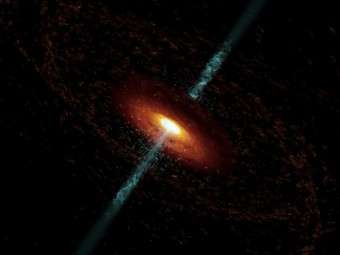Researchers quantify unidentified gamma-ray sources

In 2011, Francesco Massaro, a researcher at the University of Turin (Italy), and Raffaele D'Abrusco, a post-doc in the astrophysics group at the University Federico II of Naples (Italy), using all-sky data produced by the WISE satellite, discovered that blazars, the rarest and most extreme class of active galactic nuclei, display infrared emission with unique properties that set them apart from all other extragalactic sources.
Using this discovery, they developed a procedure to find new infrared candidate blazars. However, analysis of these findings revealed that a piece of the puzzle was still missing: The conclusive identification of these astronomical powerhouses can only be obtained through observations of their visible light in tiny wavelength intervals, which astronomers call the optical spectrum. So at the end of 2011, Massaro and D'Abrusco assembled an international team of experts and started a large observational campaign to validate the nature of the largest possible sample of candidate blazars selected with their methods through spectroscopy. Recently, the last paper of a series of six has been accepted for publication. Previous reports appeared in the Astrophysical Journal, the Astronomical Journal and Astronomy and Astrophysics. The findings discussed in these papers represent the final results of meticulous work that has contributed key pieces to the puzzle represented by this family of strange sources.
Blazars, one of the largest known classes of gamma-ray sources, are characterized as highly energetic emissions arising from a jets pointing toward the Earth, and which originate from rapidly spinning supermassive black holes in the centers of giant elliptical galaxies. The radiation from these jets is generated by particles accelerated to velocities very close to the speed of light that emit over the whole electromagnetic spectrum, from radio frequencies up to the highest energies ever detected, comparable to those released by thousands of supernovae exploding simultaneously. These powerful emissions make blazars the masters of the extragalactic gamma-ray sky.
Discovering the astronomical sources observed at lower energies that can be associated to gamma-ray sources has recently attracted significant interest. Scientists hope that understanding the connection between well-known classes of objects and blazars will reveal something completely unexpected about the universe and its evolution—including, possibly, the true nature of dark matter, an elusive particle that has so far escaped detection and whose existence can only be deduced by its gravitational influence on visible matter.
The Fermi Gamma-ray Space Telescope, an international collaboration between Italy, France, Japan, Sweden and the USA, has helped astronomers map the high-energy sky with unprecedented resolution and depth since 2008. Although Fermi has already significantly improved our knowledge of the number and characteristics of the most energetic sources in the local universe, about one-third of the gamma-ray sources detected by Fermi are still of unknown origin. The team of scientists coordinated by Massaro and D'Abrusco attempts to change that.
"Our observations represent a major improvement of our knowledge on the demographics of the unidentified gamma-ray sources and gamma-ray blazars. In the near future, the outcome of our long-term project will allow us to put new more stringent constraints on the nature, abundance and behavior of the dark matter that permeates and drives the evolution of the Universe," said Francesco Massaro.
"When we discovered that the infrared emission of Fermi blazars follows a specific pattern, our first idea was to apply our findings to the search of new infrared sources that could be responsible of the emission associated to the unidentified gamma-ray sources. While our method turned out to be very effective at selecting potential candidates, we could only confirm their nature by obtaining their optical spectra. Thus, we started a large project to verify the nature of the largest available sample of candidate blazars selected with our method." said D'Abrusco.
"We collected spectra in observatories located all around the planet. After five years and tens of observing nights spent working with telescopes in Arizona (Kitt Peak National Observatory and Multiple Mirror Telescope), California (Palomar Observatory), Chile (Southern Astrophysical Research Telescope and Magellan), the Canary Islands (Telescopio Nazionale Galileo and William Herschel Telescope) and Mexico (National Astronomical Observatory in Sa Pedro Martir and Guillermo Haro Observatory), we recently reached the milestone of 200 confirmed gamma-ray blazars among completely unknown blazars and sources whose nature was uncertain before our observational campaign."
The project has also produced other unexpected results. Two members of the team coordinated by Massaro and D'Abrusco have discovered a type of transitional blazar whose spectral continuum changes significantly over the time, and two blazars lacking a radio counterpart, which is a rarity even among the rarest class of extragalactic sources. These efforts were led by two Ph.D. students, Nuria Alvarez-Crespo at the University of Turin (Italy) and Federica Ricci at University of Roma Tre (Italy), who reduced and analyzed the spectra of several candidate blazars, exploiting the rare opportunity of working the night shifts at remote telescopes.
More information: leggi l'articolo Identification of the Infrared Non-thermal Emission in Blazars di F. Massaro, R. D'Abrusco, M. Ajello, J. E. Grindlay, Howard A. Smith, The Astrophysical Journal, 2011. adsabs.harvard.edu/abs/2011ApJ...740L..48M
leggi l'articolo The WISE Blazar-like Radio-loud Sources: An All-sky Catalog of Candidate gamma-ray Blazars di R. D'Abrusco, F. Massaro, A. Paggi, H. A. Smith, N. Masetti, M. Landoni, G. Tosti, The Astrophysical Journal Supplement, 2014. adsabs.harvard.edu/abs/2014ApJS..215...14D
leggi l'articolo Optical Spectroscopic Observations of gamma-Ray Blazar Candidates. III. The 2013/2014 Campaign in the Southern Hemisphere di M. Landoni, F. Massaro, A. Paggi, R. D'Abrusco, D. Milisavljevic, N. Masetti, H. A. Smith, G. Tosti, L. Chomiuk, J. Strader, C. C. Cheung, The Astronomical Journal, 2015. adsabs.harvard.edu/abs/2015AJ....149..163L
leggi l'articolo Refining the Associations of the Fermi Large Area Telescope Source Catalogs di F. Massaro, R. D'Abrusco, M. Landoni, A. Paggi, N. Masetti, M. Giroletti, H. Otí-Floranes, V. Chavushyan, E. Jiménez-Bailón, V. Patiño-Álvarez, S. W. Digel, H. A. Smith, A. Howard, G. Tosti, The Astrophysical Journal Supplement Series, 2015. adsabs.harvard.edu/abs/2015ApJS..217....2M
Journal information: Astrophysical Journal , Astronomical Journal , Astrophysical Journal Supplement
Provided by University of Turin




















